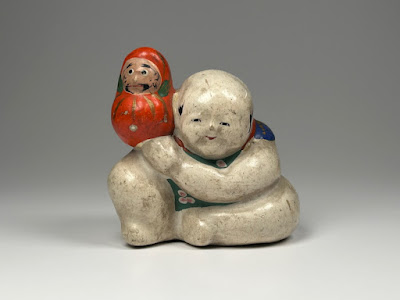後藤焼の徳利 Goto Pottery Bottle

19th century / height: 25 cm / width: 16 cm 後藤焼はくわしい史料に乏しく「幻のやきもの」と言われている(広報てんえい、No. 629、2019年)。窯跡はいまの福島県天栄村にあり、江戸後期から明治期にかけてすり鉢やカメなどの日用品を生産した。このタイプの徳利は図録・書籍などでしばしば紹介されている有名な品で、首の部分は黒釉、胴の部分は鉄釉の上にすだれ状もしくはしずく状に青白いなまこ釉がかかっている。口造りは後藤焼に独特のものとされる(日本の古徳利、1982年)。おなじ福島県の会津本郷焼や相馬大堀焼と似た点があり、技術伝播が示唆される。やや手取りが重いものの、独特の美意識が感じられ、単なる田舎の日用雑器と捨て置くことのできない、興味深い器である。 There remain many unknowns about Goto earthenwares because of lack of historical records. The pottery was located in Ten'ei Village, Fukushima, Japan, producing mortars, jars, and various necessaries in the 19th century. This type of Goto ware has been well known, decorated with black glaze and a number of "drops" of pale blue glaze. The lip's shape is characteristic in the Goto bottle. There are similarities to ceramic wares made in the Aizu-Hongo and Soma-Obori potteries, Fukushima, indicating potters and their techniques came from there. Having a distinctive sense of beauty, this bottle cannot be dismissed as


